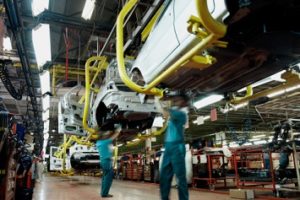Imagine performing an overhead motion nearly 5,000 times a day. Some Ford assembly line workers do just that, but new wearable technology is easing the burden. Ford has partnered with a California company to create an EksoVest, which elevates and supports a worker’s arms while performing overhead tasks.
The vest is said to be comfortable because it’s lightweight, is not bulky, and allows workers to move their arms freely. It protects against fatigue and injury by reducing the stress and strain of high-frequency, long-duration activities that can take a toll on the body over time. According to Ford, the vest can be fitted for workers of various heights, providing adjustable lift assistance of 5 to 15 pounds per arm.
The device was designed and built for environments like factories, construction sites, and distribution centers. With support from the United Automobile Workers and Ford, EksoVest is being piloted in two U.S. plants, with plans to extend the testing to regions outside the United States.
For Paul Collins, an assembly line worker at Ford’s Michigan Assembly Plant, the vest has proven valuable. “My job entails working over my head, so when I get home my back, neck, and shoulders usually hurt. Since I started using the vest, I’m not as sore, and I have more energy to play with my grandsons when I get home.”
Added UAW-Ford Vice President Jimmy Settles, “The health and safety of our membership has always been our highest priority. With the proven success at the piloted locations, we look forward to expanding this technology to our other UAW-Ford manufacturing facilities.”
Ford says EksoVest is the latest example of technology in place to reduce the physical toll on production workers. Between 2005 and 2016, the automaker saw an 83 percent decrease in the number of incidents resulting in days away, work restriction, or job transfer (DART) to an all-time low of 1.55 incidents per 100 full-time workers. Ergonomic improvements have contributed to a 90 percent decrease in risks like overextended movements.

